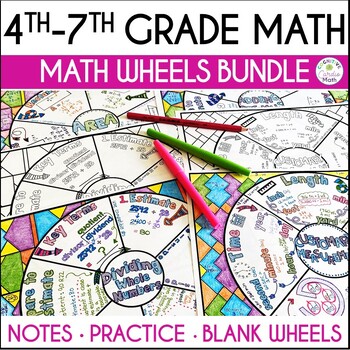4th-7th Grade Math Doodle Wheels Exponents, Inequalities, Fractions Guided Notes
- Zip
What educators are saying
Products in this Bundle (92)
showing 1-5 of 92 products
Description
Note-taking for 6th grade exponents, 5th grade dividing fractions, 7th grade probability (and more!) is so engaging with math wheels! Students love the engaging math doodle wheel format for taking notes and practicing, and the wide range of concepts covered in this bundle gives you resources for on-level instruction as well as intervention and enrichment.
- The wheels also make amazing math reference sheets, posters and anchor charts.
What is a math wheel? A math wheel is a type of graphic organizer where students can:
- Take notes/guided notes inside the math wheel
- Use color, drawing, and doodling to help create memory triggers
- Complete practice problems in the pattern around the wheel, and
- Color the background pattern
This math wheel bundle includes over 90 wheels that address concepts mostly from 4th, 5th, 6th and 7th grade standards, along with a few 'general' wheels, like Math Talk, Problem Solving Strategies, and Test-Taking Strategies.
- This bundle includes a wide range of math concepts, providing you with resources to use for on-level instruction, remediation, and extension.
Each math wheel file includes:
- Math wheel(s) with sections for each step or definition, depending on the topic
- Key with suggested notes
- Colored sample
- Editable PowerPoint file with a blank wheel (some have two blank wheels) so you can create your own math wheels (for classroom use only).
Features of these easy-to-use 4th-7th grade math resources:
- Guided notes sections and examples
- Guided or individual practice in the pattern around the circle
- Coloring/doodling opportunity: students can color the background pattern, as well as the headings and doodle arrows, making the concepts a bit more memorable
The math wheels are listed below, according to the bundles they're in (if they're in another bundle).
- Adding & Subtracting Like Fractions (focus is on meaning of adding and subtracting)
- Adding Fractions & Mixed Numbers with Like Denominators
- Comparing Decimals
- Comparing Fractions
- Customary Measurement
- Equivalent Fractions
- Factors, Prime & Composite Numbers
- Fractions to Decimals
- Metric Measurement
- Mixed Numbers & Improper Fractions
- Multiplying Fractions & Whole Numbers
- Subtracting Fractions & Mixed Numbers with Like Denominators
- Adding With Regrouping
- Angles
- Area and Perimeter
- Comparing Whole Numbers
- Dividing Whole Numbers
- Multiplying Whole Numbers
- Number Forms
- Place Value
- Points, Lines, Segments, Rays
- Rounding Whole Numbers
- Subtracting With Regrouping
- Triangles (Types of)
- Adding Decimals
- Adding Fractions
- Area (with fractional sides)
- Decimals: Reading and Writing
- Comparing Decimals
- Coordinate Plane
- Customary Measurement/Conversions
- Dividing Decimals
- Dividing Unit Fractions
- Dividing Whole Numbers
- Metric Conversions
- Multiplying Decimals
- Multiplying Fractions
- Multiplying Whole Numbers
- Polygons and Quadrilaterals
- Properties of Addition and Multiplication
- Subtracting Decimals
- Subtracting Mixed Numbers
- Volume
- Absolute Value
- Algebraic expressions (parts of and evaluating)
- Box-and-whisker plots
- Coordinate plane
- Dividing decimals
- Dividing fractions (2)
- Equivalent expressions
- Exponents
- Finding GCF and LCM (2)
- Graphing Inequalities
- Integers
- Mean absolute deviation
- Multiplying decimals
- One-step algebraic equations
- One-step inequalities
- Order of operations (2)
- Proportions and unit rates (2)
- Ratios and rates
- Surface area
- Volume
- Angles and Angle Relationships
- Circles
- Constant of Proportionality
- Combining Like Terms
- Compound Events
- Integer Operations
- Multi-step equations
- Percent Problems (discount, tax, tips)
- Probability
- Solving 2-Step Inequalities
- Unit Rates with Fractions
- Volume
5) The following math wheels are not currently in any other wheel bundle:
- Area of Quadrilaterals and Triangles
- Divisibility Rules
- Exponents Rules
- Fraction, Decimal, Percent Conversions
- Fraction Vocabulary
- Least Common Denominator
- Mean, Median, Mode, Range
- Percent of a Number
- Problem Solving Strategies
- Rational Numbers
- Rounding Decimals
- Slope
- Class Expectations
- Test-Taking Strategies
- Meet the Mathematician
- Math Talk
What teachers are saying about other math wheel guided notes bundles:
⭐️⭐️⭐️⭐️⭐️"I used these in conjunction with planning out some lessons. I love the coloring aspect because my students are in need of some new mindfulness in math."
⭐️⭐️⭐️⭐️⭐️"My students loved using this resource as notes in class. It was great to have the information all in one spot to look back at as a reference."
⭐️⭐️⭐️⭐️⭐️"This is a great resource for my students to do note taking and practice problems in their Interactive Math Notebooks. They have a lot of information in them and align very well with our standards and learning goals. I highly recommend this product! "
⭐️⭐️⭐️⭐️⭐️"I love this product! It is so much fun and it creates a whole different way to teach my students virtually. I can't wait to use this product inside the classroom next school year."
Related Resources:
Wheel Templates with Backgrounds - Editable
********************************************************************
You might also like:
5th-7th Grades Math Color by Number Bundle
6th-7th Grade Footloose Math Task Card Bundle
6th-7th Grade Problem Solving Sheets
6th-7th Grades Math Color by Number Bundle
6th-7th Grade Math Resource Bundle
7th Grade Spiral Math Review Daily Warm Ups
********************************************************************
Please keep in touch by following me, to be notified when new products are uploaded! Resources are 1/2 off for the first 24 hours, so it pays to follow!
********************************************************************
Connect with Me:
Click HERE if you'd like to get freebies from me sent to your inbox.
*********************************************************************
Copyright © Cognitive Cardio Math
Permission to copy for single classroom use only.
Please purchase additional licenses if you intend to share this resource.





